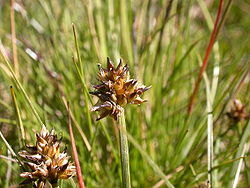Top Qs
Timeline
Chat
Perspective
Carex maritima
Species of plant From Wikipedia, the free encyclopedia
Remove ads
Carex maritima, called the curved sedge, is a species of flowering plant in the genus Carex, with a bipolar distribution in mountains and cold regions.[2][3] It dispersed in the Pleistocene from the Northern to the Southern Hemisphere.
Remove ads
Description
Carex maritima forms mats, connected by a branched system of brown, scaly rhizomes. From these rise evenly-spaced aerial shoots, most of which are vegetative, with merely a tuft of short leaves. The leaves are elongate, folded or rolled, up to 8 cm (3 in) long with serrate margins and usually tinged with bluish-grey. At intervals, there are reproductive shoots with flower spikes up to 10 cm (4 in) tall, but often much shorter; these are borne on erect, often curved, stems. The reproductive shoots have several brown, reduced or un-bladed leaves at their base, as well as 4 to 8 regular leaves. The culms are irregularly three-sided with papillose hairs between the ribs. Each flower head is a dense cluster of individual flowers that are either male or female, separated by tiny leafy bracts. The male flowers each have three stamens and the female flowers each have two or three fused carpels. Flower spikes may bear either male or female flowers, or both, and are normally wind-pollinated. The fruit is a beaked nut.[4]
Remove ads
Distribution and range
Carex maritima has a bipolar distribution. circumpolar distribution In the northern hemisphere it has a circumpolar distribution, and is found in the northern and central arctic tundra zone and the southern borders of the polar desert zone. In Europe its southern limit is Iceland and Southern Scandinavia. In the southern hemisphere it is found near the southern tip of South America. It is largely restricted to locations near the coast, but also occurs in mountainous regions of the Arctic and the boreal zone.[4]
The populations in the Northern and Southern Hemispheres are genetically and ecologically distinct. Research suggests that there was a mid to late Pleistocene migration southwards from the Northern Hemisphere, either directly or by means of mountain-hopping.[5]
Remove ads
References
Wikiwand - on
Seamless Wikipedia browsing. On steroids.
Remove ads

